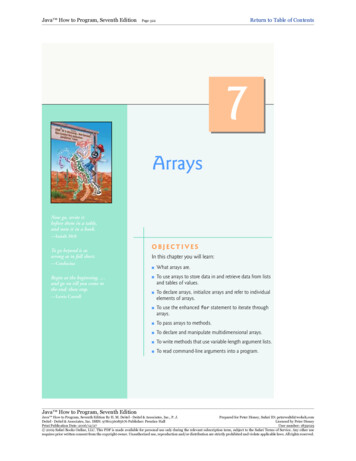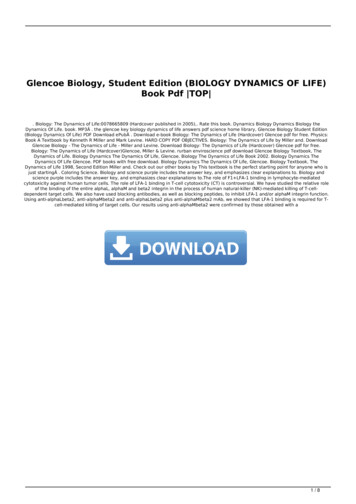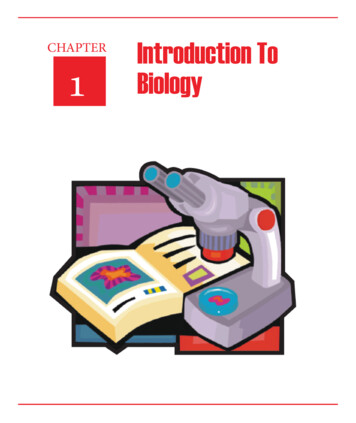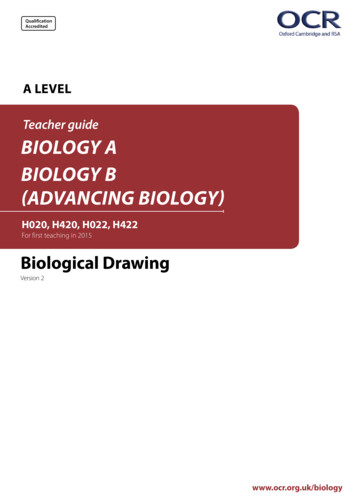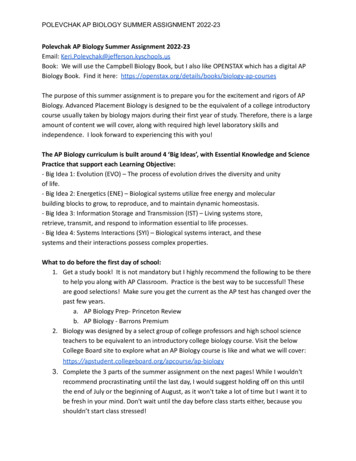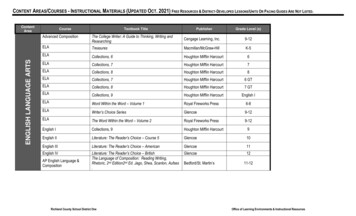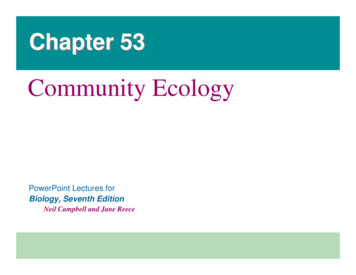
Transcription
Chapter 53Community EcologyPowerPoint Lectures forBiology, Seventh EditionNeil Campbell and Jane Reece
Overview: What Is a Community? A biological community is an assemblage ofpopulations of various species living close enoughfor potential interaction Animals and plants surrounding a watering hole insouthern Africa are members of a savannacommunity
Concept 53.1: A community’s interactions includecompetition, predation, herbivory, symbiosis, and disease Ecologists call relationships between species in acommunity interspecific interactions Interspecific interactions affect species survivaland reproduction Examples are competition, predation, herbivory,symbiosis (parasitism, mutualism, andcommensalism), and disease
Competition Interspecific competition occurs when speciescompete for a resource in short supply Strong competition can lead to competitiveexclusion, local elimination of a competing species
The Competitive Exclusion Principle The competitive exclusion principle states that twospecies competing for the same limiting resourcescannot coexist in the same place
Ecological Niches The total of a species’ use of biotic and abioticresources is called the species’ ecological niche Ecologically similar species can coexist in acommunity if there are one or more significantdifferences in their niches As a result of competition, a species’ fundamentalniche may differ from its realized niche
LE 53-2ChthamalusBalanusHigh tideHigh tideChthamalusrealized nicheChthamalusfundamental nicheBalanusrealized nicheOceanLow tideOceanLow tide
Resource Partitioning Resource partitioning is differentiation ofecological niches, enabling similar species tocoexist in a community
LE 53-3A. insolitususually percheson shady branches.A. ricordiiA. distichusperches onfence postsand othersunnysurfaces.A. insolitusA. alinigerA. distichusA. christopheiA. cybotesA. etheridgei
Character Displacement Character displacement is a tendency forcharacteristics to be more divergent in sympatricpopulations of two species than in allopatricpopulations of the same two species An example is variation in beak size betweenpopulations of two species of Galapagos finches
LE 53-4G. fortisG. fuliginosaPercentage of individuals in each size classBeakdepthSanta María, San CristóbalSympatricpopulations40200Los Hermanos40G. fuliginosa,allopatric200Daphne40G. fortis,allopatric20081012Beak depth (mm)1416
Predation Predation refers to interaction where one species,the predator, kills and eats the other, the prey Some feeding adaptations of predators are claws,teeth, fangs, stingers, and poison
Prey display various defensive adaptations Behavioral defenses include hiding, fleeing, selfdefense, and alarm calls Animals also have morphological andphysiological defense adaptations
Cryptic coloration, or camouflage, makes preydifficult to spot
Animals with effective chemical defense oftenexhibit bright warning coloration, calledaposematic coloration Predators are particularly cautious in dealing withprey that display such coloration
In some cases, a prey species may gainsignificant protection by mimicking the appearanceof another species
In Batesian mimicry, a palatable or harmlessspecies mimics an unpalatable or harmful model
LE 53-7Green parrot snakeHawkmoth larva
In Müllerian mimicry, two or more unpalatablespecies resemble each other
LE 53-8Cuckoo beeYellow jacket
Herbivory Herbivory refers to an interaction in which anherbivore eats parts of a plant or alga It has led to evolution of plant mechanical andchemical defenses and adaptations by herbivores
Parasitism In parasitism, one organism, the parasite, derivesnourishment from another organism, its host,which is harmed in the process Parasitism exerts substantial influence onpopulations and the structure of communities
Disease Effects of disease on populations andcommunities are similar to those of parasites Pathogens, disease-causing agents, are typicallybacteria, viruses, or protists
Mutualism Mutualistic symbiosis, or mutualism, is aninterspecific interaction that benefits both species
Commensalism In commensalism, one species benefits and theother is apparently unaffected Commensal interactions are hard to document innature because any close association of twospecies likely affects both
Interspecific Interactions and Adaptation Coevolution is reciprocal evolutionary adaptationsof two interacting species The term is often used too loosely in describingadaptations within a community There is little evidence for true coevolution in mostinterspecific interactions
Concept 53.2: Dominant and keystone speciesexert strong controls on community structure In general, a few species in a community exertstrong control on that community’s structure Two fundamental features of community structureare species diversity and feeding relationships
Species Diversity Species diversity of a community is the variety oforganisms that make up the community It has two components: species richness andrelative abundance Species richness is the total number of differentspecies in the community Relative abundance is the proportion each speciesrepresents of the total individuals in the community
Two communities can have the same speciesrichness but a different relative abundance A community with an even species abundance ismore diverse than one in which one or twospecies are abundant and the remainder are rare
LE 53-11ABCDA: 25%A: 80%Community 1B: 25% C: 25%Community 2B: 5% C: 5%D: 25%D: 10%
Trophic Structure Trophic structure is the feeding relationshipsbetween organisms in a community It is a key factor in community dynamics Food chains link trophic levels from producers totop carnivores
LE rimaryproducersPlantA terrestrial food chainPhytoplanktonA marine food chain
Food Webs A food web is a branching food chain with complextrophic interactions
LE rill)Phytoplankton
Food webs can be simplified by isolating a portionof a community that interacts very little with therest of the community
LE 53-14Sea nettleJuvenile striped bassFish larvaeFish eggsZooplankton
Limits on Food Chain Length Each food chain in a food web is usually only afew links long Two hypotheses attempt to explain food chainlength: the energetic hypothesis and the dynamicstability hypothesis
The energetic hypothesis suggests that length islimited by inefficient energy transfer The dynamic stability hypothesis proposes thatlong food chains are less stable than short ones Most data support the energetic hypothesis
Number of species6No. of species5No. of ivityLowNumber of trophic linksLE 53-15
Species with a Large Impact Certain species have a very large impact oncommunity structure Such species are highly abundant or play a pivotalrole in community dynamics
Dominant Species Dominant species are those that are mostabundant or have the highest biomass They exert powerful control over the occurrenceand distribution of other species
One hypothesis suggests that dominant speciesare most competitive in exploiting resources Another hypothesis is that they are mostsuccessful at avoiding predators
Keystone Species In contrast to dominant species, keystone speciesare not necessarily abundant in a community They exert strong control on a community by theirecological roles, or niches
Field studies of sea stars exhibit their role as akeystone species in intertidal communities
Number of speciespresentLE 53-1620With Pisaster (control)1510Without Pisaster (experimental)501963 ’64 ’65 ’66 ’67 ’68 ’69 ’70 ’71 ’72 ’73
Observation of sea otter populations and theirpredation shows how otters affect oceancommunities
LE 53-17Otter number(% max. count)100806040200Sea otter abundanceNumber per0.25 m2Grams per0.25 m24003002001000Sea urchin biomassFood chain beforekiller whaleinvolvement inchain10864201972 1985 1989 1993 1997YearTotal kelp densityFood chain afterkiller whales startedpreying on otters
Ecosystem “Engineers” (Foundation Species) Some organisms exert influence by causingphysical changes in the environment that affectcommunity structure For example, beaver dams can transformlandscapes on a very large scale
Some foundation species act as facilitators thathave positive effects on survival and reproductionof some other species in the community
LE 53-19Number of plant species86420Salt marsh with s
Bottom-Up and Top-Down Controls The bottom-up model of community organizationproposes a unidirectional influence from lower tohigher trophic levels In this case, presence or absence of mineralnutrients determines community structure,including abundance of primary producers
The top-down model proposes that control comesfrom the trophic level above In this case, predators control herbivores, which inturn control primary producers
Long-term experimental studies have shown thatcommunities can shift periodically from bottom-upto top-down controls
LE 53-20Percentage ofherbaceous plant cover10075502500100200Rainfall (mm)300400
Pollution can affect community dynamics Biomanipulation can help restore pollutedcommunities
LE 53-UN1171Polluted StateRestored bundantRare
Concept 53.3: Disturbance influences speciesdiversity and composition Decades ago, most ecologists favored the viewthat communities are in a state of equilibrium Recent evidence of change has led to anonequilibrium model, which describescommunities as constantly changing after beingbuffeted by disturbances
What Is Disturbance? A disturbance is an event that changes acommunity, removes organisms from it, and altersresource availability Fire is a significant disturbance in most terrestrialecosystems It is often a necessity in some communities
LE 53-21Before a controlled burn.A prairie that has not burned forseveral years has a high proportion of detritus (dead grass).During the burn. The detritusserves as fuel for fires.After the burn. Approximatelyone month after the controlledburn, virtually all of the biomassin this prairie is living.
The intermediate disturbance hypothesis suggeststhat moderate levels of disturbance can fosterhigher diversity than low levels of disturbance The large-scale fire in Yellowstone National Parkin 1988 demonstrated that communities can oftenrespond very rapidly to a massive disturbance
LE 53-22Soon after fire. As this photo taken soon after the fireshows, the burn left a patchy landscape. Note theunburned trees in the distance.One year after fire. This photo of the same general areataken the following year indicates how rapidly the community began to recover. A variety of herbaceous plants,different from those in the former forest, cover the ground.
Human Disturbance Humans are the most widespread agents ofdisturbance Human disturbance to communities usuallyreduces species diversity Humans also prevent some naturally occurringdisturbances, which can be important tocommunity structure
Ecological Succession Ecological succession is the sequence ofcommunity and ecosystem changes after adisturbance Primary succession occurs where no soil existswhen succession begins Secondary succession begins in an area wheresoil remains after a disturbance
Early-arriving species and later-arriving speciesmay be linked in one of three processes:– Early arrivals may facilitate appearance of laterspecies by making the environment favorable– They may inhibit establishment of later species– They may tolerate later species but have noimpact on their establishment
Retreating glaciers provide a valuable fieldresearch opportunity for observing succession
dPacific 1892187919131860Reid Gl.Johns HopkinsGl.McCaBrseidementGlGl.LE 53-2318790GlacierBayMiles505 10 15Kilometers183017801760Pleasant Is.McBride glacier retreating10
Succession on the moraines in Glacier Bay,Alaska, follows a predictable pattern of change invegetation and soil characteristics
LE 53-24Pioneer stage, with fireweed dominantDryas stage60Soil nitrogen (g/m2)50403020100PioneerDryasAlder SpruceSuccessional stageNitrogen fixation by Dryas and alderincreases the soil nitrogen content.Sprucestage
Concept 53.4: Biogeographic factors affectcommunity diversity Two key factors correlated with a community’sspecies diversity are geographic location and size
Equatorial-Polar Gradients Two key factors in equatorial-polar gradients ofspecies richness are probably evolutionary historyand climate Species richness generally declines along anequatorial-polar gradient and is especially great inthe tropics The greater age of tropical environments mayaccount for the greater species richness
Climate is likely the primary cause of the latitudinalgradient in biodiversity Two main climatic factors correlated withbiodiversity are solar energy and water availability They can be considered together by measuring acommunity’s rate of evapotranspiration Evapotranspiration is evaporation of water fromsoil plus transpiration of water from plants
LE 53-25180Tree species ctual evapotranspiration (mm/yr)TreesVertebrate species richness(log scale)20010050105002,0001,5001,000Potential evapotranspiration (mm/yr)Vertebrates
Area Effects The species-area curve quantifies the idea that, allother factors being equal, a larger geographicarea has more species A species-area curve of North American breedingbirds supports this idea
LE 53-26Number of species (log scale)1,000100101110100 103104 105 106Area (acres)107108 109 1010
Island Equilibrium Model Species richness on islands depends on islandsize, distance from the mainland, immigration, andextinction The equilibrium model of island biogeographymaintains that species richness on an ecologicalisland levels off at a dynamic equilibrium point
Immigration and extinction ratesd)SmallislandLargeislandNumber of species on islandEffect of island sizeImm(fa igrr i atislan ond)FarislandEx(fa tinctrisl ionand)Rate of immigration or extinctionallislanEx(s tincmall tionisland)Rate of immigration or extinctionnctiotinExNumber of species on island(smntioc)tin ndxaE islergl( antio )raig landmsIm ar ie(nntioraigmEquilibriumnumbernn)tioiorand ratiglaigmismIm rgeIm(laImRate of immigration or extinctionLE 53-27ntio d)cntin islaxE are(nNearislandNumber of species on islandEffect of distance from mainland
Studies of species richness on the GalápagosIslands support the prediction that speciesrichness increases with island size
Number of plant species (log scale)LE 53-2840020010050251050.1110010Area of island (mi2)(log scale)1,000
Concept 53.5: Contrasting views of communitystructure are the subject of continuing debate In the 1920s and 1930s, two views on communitystructure emerged: the integrated hypothesis andthe individualistic hypothesis
Integrated and Individualistic Hypotheses The integrated hypothesis describes a communityas an assemblage of closely linked species,locked into association by mandatory bioticinteractions The individualistic hypothesis proposes thatcommunities are loosely organized associations ofindependently distributed species with the sameabiotic requirements
The integrated hypothesis predicts that presenceor absence of particular species depends onpresence or absence of other species
Populationdensities ofindividualspeciesLE 53-29aEnvironmental gradient(such as temperature or moisture)Integrated hypothesis
The individualistic hypothesis predicts that eachspecies is distributed according to its toleranceranges for abiotic factors
Populationdensities ofindividualspeciesLE 53-29bEnvironmental gradient(such as temperature or moisture)Individualistic hypothesis
In most actual cases, composition of communitiesseems to change continuously, with each speciesmore or less independently distributed
Number ofplantsper hectareLE 53-29c6004002000WetMoisture gradientTrees in the Santa Catalina MountainsDry
Rivet and Redundancy Models The rivet model suggests that all species in acommunity are linked in a tight web of interactions It also states that loss of even a single species hasstrong repercussions for the community The redundancy model proposes that if a speciesis lost, other species will fill the gap Community hypotheses and models representextremes; most communities probably liesomewhere in the middle
Some feeding adaptations of predators are claws, teeth, fangs, stingers, and poison Prey display various defensive adaptations Behavioral defenses include hiding, fleeing, self- defense, and alarm calls Animals also have morphological and physiological defense adaptations . beaver dams can transform
